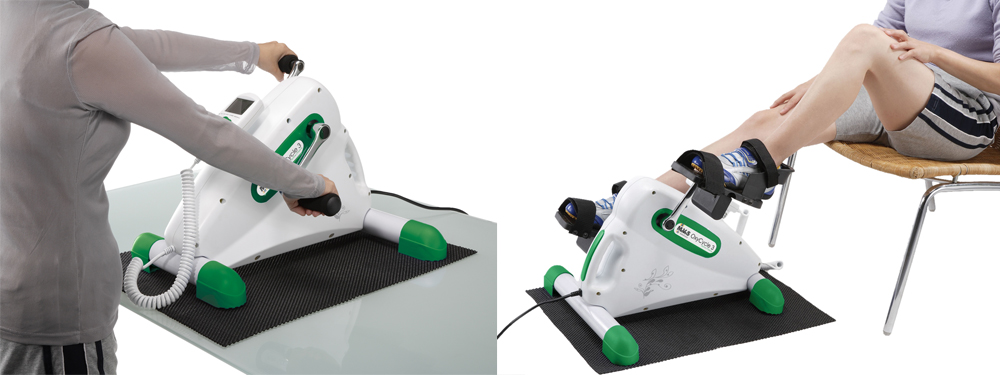Hand and foot operated bicycle ergometers provide an excellent opportunity for patients recovering from chronic illness, injury, or stroke. They can be used to train both upper and lower limbs. Research has shown that using an arm ergometer or leg cycle positively impacts post-stroke recovery. They help improve arm and leg strength as well as cardiovascular health.
The Mambo Max ElliptiStep is a compact, seated elliptical trainer. Its electromagnetic operation makes it ideal for home, office, or rehabilitation use.
Research has proven that using an arm ergometer or leg cycle benefits post-stroke recovery. They aid in strengthening the arms and legs, as well as improving cardiovascular health. The bike's resistance is adjusted by a physiotherapist according to the patient's current condition. Proper resistance ensures the effort required is suitable for the patient.
The purpose of using the arm bicycle is to strengthen arms and legs so that the stroke patient can better perform tasks like eating, dressing, and walking.
There are active and passive ergometers. The active ergometer "does not turn by itself," meaning it is always moved by the user's physical effort.
In the case of a passive ergometer, an "automatic" function can be set. This way, the ergometer "pulls" the limb along, assists the movement, and can even move a completely immobile or paralyzed limb. This assistance is necessary when the patient has not yet regained movement ability after a stroke.
Ergometer in stroke rehabilitation
Stroke is one of the leading causes of long-term disability in adults. One of the most common consequences of stroke is hemiparesis, paralysis of the muscles on one side of the body. This often leads to the patient being unable to walk without assistance and dependent on others. Help is needed even for activities such as eating, bathing, and dressing.
Walking difficulties, muscle weakness, spasticity, poor motor control and coordination, balance disorders, and loss of sensation can present significant challenges for stroke patients.
It is recommended that patients start specialized physiotherapy as soon as possible after a stroke to retrain the body for proper movement, improve blood flow, and maintain muscle strength.
Since stroke recovery may take months or even years, an ergometer at home is an important tool for stroke rehabilitation. It is one of the most advantageous exercise and rehabilitation methods for stroke patients.

Stimulating the muscles of the arms and legs after stroke can help improve movement and walking ability
It stimulates voluntary movement - Walking requires continuous and repetitive motion, which is difficult or impossible after a stroke. The bicycle trainer enforces coordinated and symmetrical movement with both legs, which may lead to improved walking over time.
After stroke - once the life-threatening phase has passed - it can be used almost immediately. In the initial phase, the patient may be unable to practice walking. The bicycle trainer can assist in rebuilding damaged muscles and neural pathways.
It is not only useful during rehabilitation. Even after daily and weekly therapeutic treatments are no longer necessary, the bicycle trainer is a great tool for a healthy lifestyle. Many stroke patients find it challenging to maintain an active lifestyle, so incorporating time on the bicycle trainer can help establish a healthy routine. This daily activity can help prevent stroke recurrence.
It is a very safe tool in post-stroke recovery - With a seated or standing bicycle trainer, no balancing is needed, so the risk of falling and fear of falling are greatly reduced, and most patients can use it almost entirely independently.
Progress can be tracked - Results of cycling are traceable and visible as the patient's condition improves.
Training programs are easily adjustable. Most ergometers offer settings that allow the user to tailor the workout to their own needs.
- High resistance and low speed focus on muscle building.
- Low resistance and high speed improve cardio-respiratory endurance, enhancing heart function, blood circulation, lung, and breathing efficiency.














